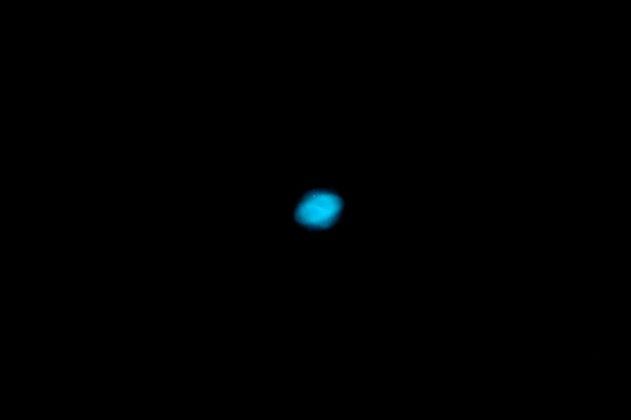
Saturn Nebula, Blue Snowball, Double Cluster
Observatory opened Wednesday, 3 November, at 1804 MST, 73°F, under clear skies. I was hoping to image NGC 6723, NGC 6726/7, and IC 4812 with the D7000 DSLR. I had previously imaged them with the D70 DSLR. Unfortunately, they were too low in the southwestern sky after dark. I did view NGC 6723, the globular cluster, in the 26mm eyepiece before twilight ended. I then viewed Jupiter in the 26mm; four moons were visible. I next slewed to NGC 7009, the Saturn Nebula. It was a nice object in the 26mm eyepiece. Then I began setting up for D7000 DSLR imaging. I focused the camera at prime focus using the star Altair with the Bahtinov Mask and the D7000 Live View. The photo above, taken with my iPhone 4, shows the D7000 LCD, zoomed in on the star’s pattern through the mask. You can see how easy it is to center the spikes to achieve proper focus with the Mask and Live View.
I took 5, 10, and 20 second, ISO 2000, unguided, exposures of NGC 7009, Saturn Nebula. The 20 second exposure was the best. Here it is, edited and cropped:

Next was NGC 7662, the Blue Snowball. I again did 5, 10, and 20 second, ISO 2000, unguided exposures. Here is the 20 second exposure, edited, and cropped to the same scale as the Saturn Nebula image:

I ended DSO imaging and viewed the Double Cluster open star clusters in the 26mm eyepiece. Always a nice sight. I then spent some time viewing M33, a large spiral galaxy. I first used the 26mm eyepiece; nice. I switched to the 2” 30mm eyepiece for a wider view of this large galaxy. Some spiral structure was visible. I then added the f/6.3 focal reducer; it didn’t really improve the view of M33. Slewed to M31, the Andromeda Galaxy. Structure was visible across the entire FOV and M32 and M110 were easily seen in the same FOV with M31. Switched to the 2” 50mm eyepiece; really a nice view. I then went back to the Double Cluster; both clusters were in the 2” 50mm + focal reducer FOV. A very pretty sight.
At 1930 MST, the wind started kicking up. During the daytime, there had been some strong winds (gusts to 39 MPH), but the wind had died down at sunset. I decided to image the Double Cluster with the D7000. Focused on Algol with the Mask and Live View. Both clusters were easily seen in the camera viewfinder. I took a 30 second, ISO 2000, prime focus + focal reducer, unguided, exposure. It looked good on the camera LCD so I decided to try a 30 second, ISO 4000, unguided, exposure. Here is the ISO 4000 image, slightly edited, at full-frame:

In the original image, star colors are very apparent.
The wind was getting annoying now so I decided to close up the observatory. It was closed at 2030 MST, 67°F. As it turned out, the winds continued to blow all night, up to 30 MPH, with a gust to 44 MPH.
Thursday, November 4, 2010

